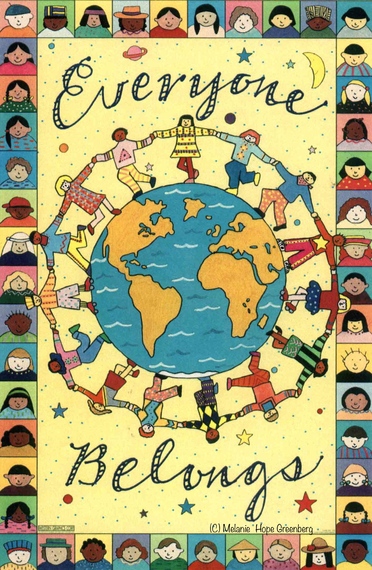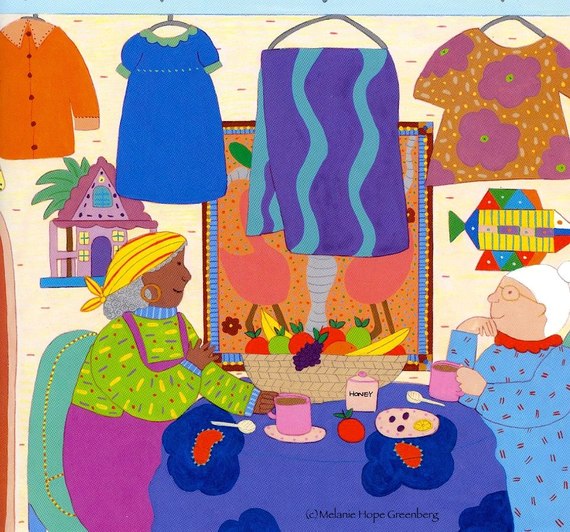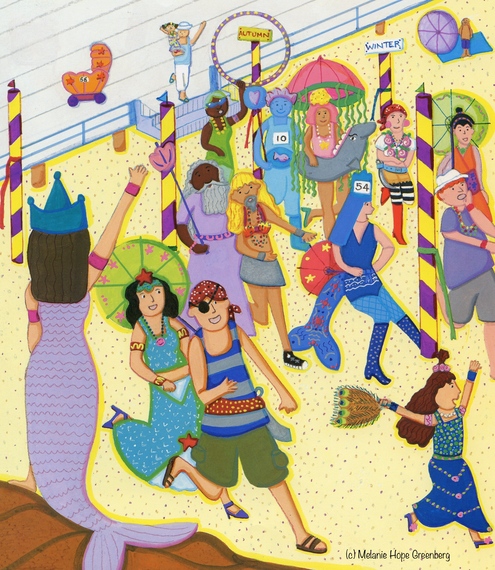My attention to cultural diversity started with my third published picture book,
It's My Earth Too / Doubleday 1992. In that book, I depicted children from all over the world. I became painfully aware that the characters in my first two books were only white. I am white and Jewish and grew up in a lower middle class neighborhood in the South Bronx in New York City. I went to public school with many students who were Black, Hispanic and Asian. Cultural diversity has always surrounded me. I ride the New York City subways with people of every nationality, race, shape, size, age, gender, color, and costume, where tolerance and democracy are practiced. This is the world I see on a daily basis. A world that is not homogenized. These days, the characters in my books and other published illustrations show various skin shades, cultures, and genders; reflecting the world that I experience.
Picture book crafting challenges me to depict life in its simplest forms. At the same time the craft is multi-dimensional. I've always enjoyed paintings which tell several stories captured in a single frame. When crafting a picture book the text tells a story and whether I am the book's author or not, my art must serve to tell that story. In addition, a story conveyed in art and symbolism can tell several other stories silently. That transcendence leaves room to invite young people to add their interpretations.
In 1995, I wrote and illustrated a picture book called Aunt Lilly's Laundromat. It's a story of a hardworking immigrant, a Haitian woman who blends her native Caribbean culture with Brooklyn culture. It's also about carrying on the traditions of one's culture from generation to generation, no matter where one lives. The original idea came from seeing the hardworking Asian owner of the laundromat that I use asleep in a chair in the back room. That touched me. However, I layered the book's working world using Caribbean culture because I am a big fan of Haitian artists; I used my artistic license to honor them which felt authentic.
I also illustrated Down in the Subway / Star Bright Books 2003. The Caribbean culture I painted was chosen by the author, Miriam Cohen, who was writing about a real life friend. In that book, I blend Caribbean culture with symbols from ancient Hinduism and my yoga practice philosophies. I painted several silent stories using symbolism. I realized during the process of crafting this book that the main character is Mother Nature appearing as a colorful woman on the New York City subway. She grants gifts of the four elements: breezes (air), seas (water), food (earth), and the creative musicians (fire). In the picture book, Good Morning Digger / Viking 2005, I illustrated the main characters as African American because that fit a story which takes place in an urban environment.
My recent book, Mermaid On Parade, includes diverse New York City community members. Youth Wing managers from Brooklyn Central Library told me that when young people in Brooklyn see themselves reflected in books they are more likely to get excited about reading. Auspiciously, I became invited to march in Brooklyn's Coney Island Mermaid Parade with a performing arts troupe from Dumbo. At the parade I took photos and notes as ideas for a possible book. I saw every race, shape, size, age, gender, color, costumes, and no costumes; a psychedelic honky tonk which took tolerance and democracy to a new level. However, knowing my book audience is PreK to Second Grade, I kept the tone of the text, art, and costumes child-like and "carnival".
While writing Mermaids on Parade I loved researching Coney Island's history with its own culturally diverse communities. I knew I could express that in my art. I playfully include people from my photos such as a man in a miniskirt, seashell bra, beads, high-top sneakers, long blonde wig and a beard. That's how I add layers of real life experiences to the main story. Moustached women, mermaids with beards, and a blue skinned creature fit naturally into the fabric of every day life.
The Mermaid Parade which takes place during the Summer Solstice, is a hodgepodge of different rituals taken from several cultures. I include in the book a ritual to open the ocean. King Neptune and Queen Mermaid cut four ribbons along a path on the beach which represent the four seasons, then, they jump in the waves, throwing various fruits in the ocean to appease their sea deities.
Books spark the imagination for discussion with young people. Influences from real life, diverse cultures, and communities in the city where I live find their way into my books. I share these experiences with young people to get them excited about reading. If they relate to either Brooklyn, or a subway, or a digger, or Coney Island, or a parade, or about getting dressed up in a costume, it sparks the love of reading. Young people see what I see then paint into my books. Stories which include diversity, tolerance, and democracy help us know that we are all together and that we all belong.
This modified article was originally published online by Hunger Mountain Journal of the Arts, Vermont School of Fine Arts.
All art is copyright Melanie Hope Greenberg



